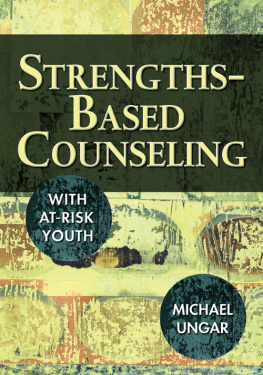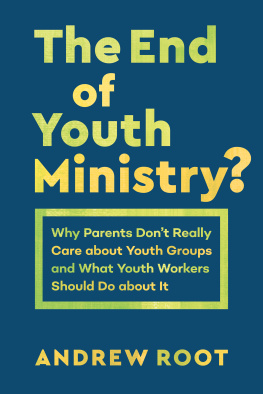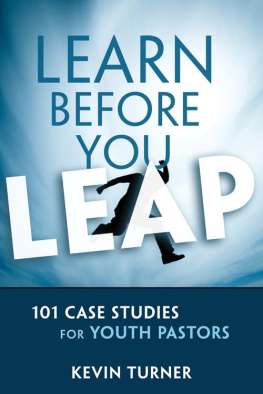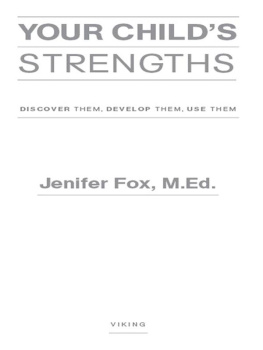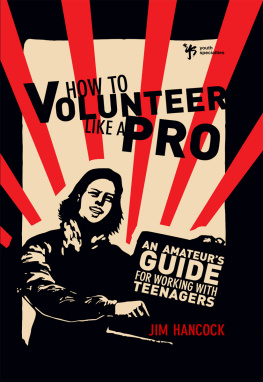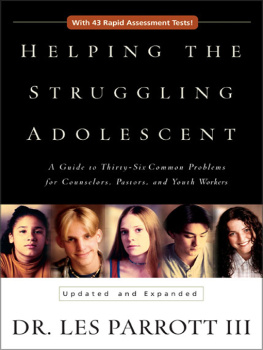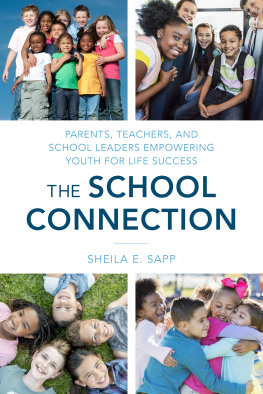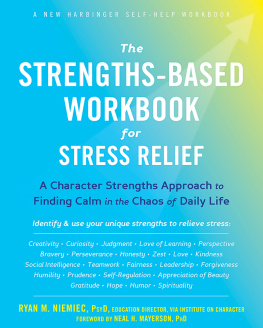
Copyright 2006 by Corwin Press
All rights reserved. When forms and sample documents are included, their use is authorized only by educators, local school sites, and/or noncommercial entities who have purchased the book. Except for that usage, no part of this book may be reproduced or utilized in any form or by any means, electronic or mechanical, including photocopying, recording, or by any information storage and retrieval system, without permission in writing from the publisher.

For information:

Corwin Press
A Sage Publications Company
2455 Teller Road
Thousand Oaks, California 91320
www.corwinpress.com
Sage Publications Ltd.
1 Olivers Yard
55 City Road
London EC1Y 1SP
United Kingdom
Sage Publications India Pvt. Ltd.
B-42, Panchsheel Enclave
Post Box 4109
New Delhi 110 017 India
Printed in the United States of America.
Library of Congress Cataloging-in-Publication Data
Ungar, Michael, 1963
Strengths-based counseling with at-risk youth / Michael Ungar.
p. cm.
Includes bibliographical references and index.
ISBN 1-4129-2819-2 (cloth) ISBN 1-4129-2820-6 (pbk.)
1. Youth with social disabilitiesServices for. 2. Problem youthServices for. I. Title.
HV1421.U54 2006
616.8900835dc22
2005025358
This book is printed on acid-free paper.
06 07 08 09 10 9 8 7 6 5 4 3 2 1

Acquisitions Editor: Stacy Wagner
Production Editor: Jenn Reese
Copy Editor: Marilyn Power Scott
Typesetter: C&M Digitals (P) Ltd.
Proofreader: Caryne Brown
Cover Designer: Rose Storey
Graphic Designer: Lisa Miller

T here on the front page of The Daily News in Halifax, Nova Scotia, was the headline that I knew was coming: Loser kills one at Alberta School (1999), announcing another shooting at a high school just days after the mass shooting at Columbine in Boulder, Colorado. I had said to friends and family after I heard about Columbine that it would be only a matter of time and there would be another copycat incident.
Sadly, I was wrong. There hasnt been just one, but many similar incidents. There have also been literally thousands of threats heard throughout schools and other public institutions from youth who feel as if they have nothing to lose and everything to gain by acting violently. It was that bolded word Loser in the headline that made it all so inevitable.
Thanks to the miracle of mass media, that young boy thousands of miles from Columbine was shown exactly what he could do if he wanted instant notoriety. We handed him the script. In a world where there are few options for such a dramatic shift in identity, this loser found a way out of a lifetime of stigma and exclusion. If he had instead found a group of similarly disenfranchised youth who had managed other ways to make the same statement, could he have borrowed from them some of their status to shore up his own flagging self-image? Was there no other alternative to violence and murder?
Of course we could blame his family or his teachers for allowing him to be bullied. Or if we are of a different political stripe, we could argue that he would have been deterred from his crime if only we had harsher punishments for young offenders. We might debate issues of gun control and speculate on how we ever let a boy his age in his state of mind get hold of a gun. But the sad truth is that none of these political and ideological musings will solve the problems kids face. The truth is that while that boy may have been a loser before, he will from this point on have a much more powerful identity, one partly of his own design but one that shares the status given a growing number of school-aged children: Murderer.
This book is about preventing these tragedies, both great and small. Young people dont have to cope with their problems by becoming violent or acting out in other socially unacceptable ways. Over the years, adolescents and their families have shown me that they survive best when they are helped to find healthy and powerful identities that others recognize both at school and at home. This approach to problem youth, whether they are acting out violently or simply beginning to cause their teachers and caregivers worry, offers hope. It looks beyond the psychopathology and bad behavior of our youth to better understand them and their ways of coping as adaptive, no matter how irrational their behavior may seem at the time. This book is meant as a roadmap through the facade of dangerous, delinquent, deviant, and disordered behaviors found among troubled kids. It will show that educators, like parents and other adults, still play a large part in the lives of these teenagers and, whats more, that teenagers want and need adults to be there for them.
How to Use This Book
This book will help you to look at youth differently. It begins with a discussion of problem youth, offering an innovative way of seeing them as pandas, chameleons and leopards. These three labels are ways youth and I have found to describe young peoples patterns of coping and surviving. Pandas are stuck with one pattern, chameleons adapt to the environments they find themselves in, while leopards change the environments around them. The first two chapters will share many stories about these youth, including my own experience as a teenager, in order to show how kids use these coping strategies to nurture and maintain resilience. provide six strategies that I use in my work with troubled youth and their teachers and families. Each strategy builds on the strengths youth show as pandas, chameleons, and leopards, encouraging a more positive and individualized understanding of why youth act out in troubling ways. There is much in these chapters for educators and caregivers struggling to find the tools necessary to help the youth in their care.
applies these strategies to kids who bully. There are a number of problems that could be discussed. Bullying, however, like other forms of violence, is one of those pervasive problems that we are struggling to address in our schools and communities. Looking at bullies as pandas, chameleons, and leopards and applying the six strategies for intervention will bring together all the ideas presented in earlier chapters into a comprehensive model of strengths-based intervention.
kids. The tool is not meant to add the label of resilient or nonresilient to individual youth; it is instead a checklist of items we should examine when we consider how best to help our children become more resilient. In the discussion that follows the presentation of the Inventory, I stress the need to see even problem behavior as signs of resilience in contexts that lack resources for healthy development. Scoring the Inventory helps us to appreciate the unique solutions our young people use to survive.

